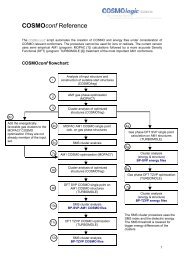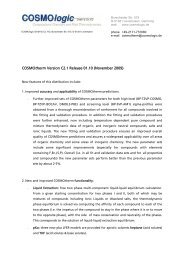New Insights into the Thermal Degradation of ... - CAChe Research
New Insights into the Thermal Degradation of ... - CAChe Research
New Insights into the Thermal Degradation of ... - CAChe Research
Create successful ePaper yourself
Turn your PDF publications into a flip-book with our unique Google optimized e-Paper software.
<strong>Thermal</strong> <strong>Degradation</strong> <strong>of</strong> PolymersDavid A. Gallagher, <strong>CAChe</strong> Group, Fujitsu America, Inc.The following is a summary <strong>of</strong> <strong>the</strong> article "Computer-aided Chemistry Techniques Reveal <strong>Thermal</strong><strong>Degradation</strong> mechanisms <strong>of</strong> Polymers" published in Scientific Computing & Automation 1 .AbstractAn approach to predicting and understanding <strong>the</strong>rmal degradation mechanisms <strong>of</strong>polymers is described. MOPAC PM3 2 calculations on Nylon 66 using <strong>the</strong> <strong>CAChe</strong>WorkSystem 3 s<strong>of</strong>tware corroborate experimental observations 4,5,6,8 and provide newinsights <strong>into</strong> <strong>the</strong> <strong>the</strong>rmal degradation mechanisms <strong>of</strong> Nylon. Formation <strong>of</strong>cyclopentanone by <strong>the</strong>rmal degradation, previously reported in <strong>the</strong> literature 8 asunexplained, is hereby rationalized.IntroductionExperimental tests are both time-consuming and expensive because <strong>the</strong>y require that anew polymer actually be syn<strong>the</strong>sized and processed. The ability to predict <strong>the</strong>rmaldegradation mechanisms and <strong>the</strong>rmodynamics by computer-aided chemistry can savesignificant time and money, as little or no experimental work may be required.Fur<strong>the</strong>r, <strong>the</strong> computer-aided chemistry approach <strong>of</strong>ten provides new insights <strong>into</strong> <strong>the</strong>mechanism <strong>of</strong> <strong>the</strong>rmal decomposition and formation <strong>of</strong> breakdown products that areunavailable by experimental techniques. This ability to explore <strong>the</strong> relationship betweena molecule's structure and its chemical and physical properties allows for a moresystematic approach to <strong>the</strong> design <strong>of</strong> new polymers and processes.ApproachFor expediency, <strong>the</strong> smallest representative section <strong>of</strong> each polymer or polymerfragment to be investigated was sketched in <strong>the</strong> <strong>CAChe</strong> Workspace and entered <strong>into</strong> a<strong>CAChe</strong> ProjectLeader spreadsheet. The polymer and radical fragments typically variedbetween one and two repeat units for most <strong>of</strong> <strong>the</strong> calculations performed here. Variousproperties such as heats <strong>of</strong> formation and Gibbs free energies at different temperatureswere automatically calculated in <strong>the</strong> spreadsheet using <strong>the</strong> default procedures basedon MOPAC PM3.Figure 1. Stretch to breaking pointThe basis for this calculation is <strong>the</strong> map reaction property (MOPAC PM3 UHF optimized reactioncoordinate). The <strong>CAChe</strong> WorkSystem automates <strong>the</strong> set up, calculation and graphical interpretation <strong>of</strong> <strong>the</strong>results for <strong>the</strong> user.<strong>Thermal</strong> <strong>Degradation</strong> <strong>of</strong> Polymers, D. A. Gallagher, <strong>CAChe</strong> Group, Fujitsu, ©2002 Page 1
Stretch to breaking pointIn <strong>the</strong> absence <strong>of</strong> specific reactions, such as a retro Diels-Alder, condensation orhydrolysis reactions, etc., <strong>the</strong> initial step in any <strong>the</strong>rmal decomposition is likely to bebond homolysis. It is assumed that <strong>the</strong> weakest bond will break first on heating, andthat <strong>the</strong> weakest bond will also break first on stretching <strong>the</strong> chain. Thus, to identify <strong>the</strong>weakest bond, equivalent atoms at each end <strong>of</strong> <strong>the</strong> repeat unit were pulled until a bondsnapped. This was modeled by placing a Search Label between <strong>the</strong> atoms at each end<strong>of</strong> <strong>the</strong> polymer repeat unit. Using <strong>the</strong> Map reaction property, <strong>the</strong> atoms were pulledapart in increments <strong>of</strong> 0.05 Angstroms and re-optimized at each step until <strong>the</strong> chainbroke, as illustrated in Figure 1. The multiplicity setting for <strong>the</strong> MOPAC PM3procedure for this calculation was changed to UHF to allow for unpaired electrons(radicals).Figure 2. Radical attack forms cyclopentanoneThe radical susceptibility surface shown here is derived from Fukui's Frontier Density <strong>the</strong>ory 6 and iscreated by calculating <strong>the</strong> radical susceptibility property in <strong>CAChe</strong>.<strong>Degradation</strong> productsThis first bond that breaks leaves a free methylene radical and a free carbonyl radical.Figure 2 was generated by calculating <strong>the</strong> radical susceptibility property <strong>of</strong> <strong>the</strong> Nylonchain and shows that <strong>the</strong> carbonyl carbon is <strong>the</strong> part <strong>of</strong> <strong>the</strong> Nylon 66 chain that is mostsusceptible to free radical attack 6 (an arrow points at <strong>the</strong> highest radical susceptibility,shown in red). If <strong>the</strong> methylene radical were to fold back and attack this susceptiblecarbonyl carbon, <strong>the</strong>n cyclopentanone could be formed. Cyclopentanone is, indeed,reported as one <strong>of</strong> <strong>the</strong> major <strong>the</strong>rmal breakdown products 4,7,8 <strong>of</strong> Nylon 66.<strong>Thermal</strong> <strong>Degradation</strong> <strong>of</strong> Polymers, D. A. Gallagher, <strong>CAChe</strong> Group, Fujitsu, ©2002 Page 2
Comparing kinetic barriers <strong>of</strong> each bond dissociationAn alternative and more systematic approach is to stretch each individual bond to itsbreaking point (ra<strong>the</strong>r than <strong>the</strong> repeat unit as a whole) and plot <strong>the</strong> heat <strong>of</strong> formation(enthalpy) as a function <strong>of</strong> bond extension, as shown in Figure 3. In any case, thisapproach may be necessary to account for homolysis in side chains, which would beunaffected by stretching <strong>the</strong> repeat unit.kcals*Figure 3. Map reaction results for <strong>the</strong> CO-CH 2 bond homolysisThe approximate transition state (marked with * in Figure 3) was <strong>the</strong>n refined for eachbond stretch and <strong>the</strong> heat <strong>of</strong> formation calculated to derive <strong>the</strong> relative kinetic stabilities<strong>of</strong> every bond as listed in Table 1. The lowest energy transition state was that <strong>of</strong> <strong>the</strong>carbonyl-methylene bond, which is consistent with <strong>the</strong> results <strong>of</strong> <strong>the</strong> "stretch-tobreaking-point"for <strong>the</strong> whole repeat unit. The heats <strong>of</strong> formation <strong>of</strong> <strong>the</strong> transition stateswere typically only a few kcals above <strong>the</strong> heats <strong>of</strong> formation <strong>of</strong> <strong>the</strong> radical products, i.e.<strong>the</strong> kinetic barriers were only slightly higher than <strong>the</strong> heats <strong>of</strong> reaction.Åbondnumbertransition stateheat <strong>of</strong>formation(kcal/mole)all negativevibrations(cm-1)1 Nylon C-C(CCN) ts -29.7 -153.32 Nylon C-C(CN) ts -29.6 -171.93 Nylon C-C(N) ts -34.4 -80.34 Nylon N-CH2 ts -24.3 -270.65 Nylon N-CO ts -31.6 -234.56 Nylon CO-CH2 ts -35.5 -85.07 Nylon C-C(CO) ts -26.5 -114.08 Nylon C-C(CCO) ts -27.4 -131.7Table 1. Backbone bonds homolysis transition state energiesThe approximate transition states from <strong>the</strong> map reaction calculation were refined using <strong>the</strong> refinetransition state calculation. Verify transition state was <strong>the</strong>n used to generate <strong>the</strong> vibrational spectrum.A single negative vibration confirms that a true transition state has been found. PM3 calculations aretypically accurate to about 8 kcals 2 , although, as systematic errors will cancel, <strong>the</strong> energy differencescould be expected to be much more accurate.<strong>Thermal</strong> <strong>Degradation</strong> <strong>of</strong> Polymers, D. A. Gallagher, <strong>CAChe</strong> Group, Fujitsu, ©2002 Page 3
Thermodynamic (heats <strong>of</strong> formation) calculations revealed that <strong>the</strong> lowest energyproducts <strong>of</strong> hydrogen radical formation were at least 10 kcals higher than <strong>the</strong> highest <strong>of</strong><strong>the</strong> backbone homolysis products. Hence, <strong>the</strong> kinetic barriers <strong>of</strong> hydrogen radicalformation would be too high to be <strong>the</strong> initial bond homolysis step and so were notstudied fur<strong>the</strong>r.Kinetic versus <strong>the</strong>rmodynamic controlThe bond dissociation energies (heat <strong>of</strong> reaction) for each <strong>of</strong> <strong>the</strong> backbone bonds werealso calculated (Table 2) and are illustrated in Figure 4. The three lowest backbonefission enthalpies were calculated to be within one kcal <strong>of</strong> each o<strong>the</strong>r. While <strong>the</strong> lowes<strong>the</strong>at <strong>of</strong> reaction for bond fission (nitrogen-carbonyl bond) did not correspond to <strong>the</strong>lowest kinetic barrier (carbonyl-methylene bond), <strong>the</strong> next two bond fission enthalpiesdid correspond to <strong>the</strong> two lowest kinetic barriers. Only fission at <strong>the</strong> carbonyl-methylenebond gives <strong>the</strong> direct opportunity to form cyclopentanone, <strong>the</strong> major experimentallyobserved breakdown product 4,7,8 <strong>of</strong> Nylon 66. Thus, <strong>the</strong>rmal homolysis <strong>of</strong> Nylon 66appears to be controlled by <strong>the</strong> kinetically predicted bond fission and not <strong>the</strong><strong>the</strong>rmodynamically favored products.• chain homolysis12345 67 8• proton radicalsH1H2H3H5H6Figure 4. Bonds studied for homolysis calculationsActivation energyBy comparing <strong>the</strong> ground state and transition state structures, <strong>the</strong> <strong>CAChe</strong> WorkSystemalso predicted that <strong>the</strong> Gibbs free energy <strong>of</strong> activation at 360 o C was 41 kcals for <strong>the</strong>homolysis <strong>of</strong> <strong>the</strong> carbonyl-methylene bond. This is in good agreement with <strong>the</strong>experimentally derived values 5,8 <strong>of</strong> 34 - 43 kcals. The purer <strong>the</strong> Nylon sample, <strong>the</strong>higher is <strong>the</strong> experimental value observed.<strong>Thermal</strong> <strong>Degradation</strong> <strong>of</strong> Polymers, D. A. Gallagher, <strong>CAChe</strong> Group, Fujitsu, ©2002 Page 4
adical Aheat <strong>of</strong>formationkcal/molradical Bheat <strong>of</strong>formationkcal/moltotal heat<strong>of</strong>formationsplit = /1a -30.778 1b -84.211 -114.989 (C6) C4/C3 (N)2a -35.278 2b -80.262 -115.540 (C6) C3/C2 (N)3a -41.865 3b -79.332 -121.197 (C6) C2/C1 (N)4a -46.139 4b -69.408 -115.547 (C6) C1/N5a -44.119 5b -77.953 -122.071 N/CO6a -86.020 6b -35.518 -121.538 CO/C1 ( C4)7a -83.660 7b -30.042 -113.702 (CO) C1/C2 (C4)8a -90.420 8b -24.147 -114.566 (CO) C2/C3 (C4)Nylon full rad -H -155.729 H. 52.102 -103.627 CH2 CH. NH / H.Table 2. Heats <strong>of</strong> formation <strong>of</strong> fragments from bond homolysisConclusionA possible mechanism for <strong>the</strong> production <strong>of</strong> cyclopentanone from <strong>the</strong> <strong>the</strong>rmaldegradation <strong>of</strong> Nylon 66 has been uncovered. Computer-aided chemistry can be usedto predict and gain insight <strong>into</strong> <strong>the</strong> <strong>the</strong>rmal degradation mechanisms <strong>of</strong> polymers in afraction <strong>of</strong> <strong>the</strong> time it would take to perform <strong>the</strong> necessary experiments. Such insightfacilitates <strong>the</strong> systematic design <strong>of</strong> new polymers with more desirable properties.References:1. D. A. Gallagher, Computer-aided Chemistry Techniques Reveal <strong>Thermal</strong> <strong>Degradation</strong> Mechanisms <strong>of</strong>Polymers, Scientific Computing & Automation, June 1996.2. J. J. P. Stewart, J. Comp. Chem., 10, 221-264 (1989)3. <strong>CAChe</strong> WorkSystem, <strong>CAChe</strong> Group, Fujitsu, 15244 NW Greenbrier Parkway, Beaverton, OR 97006,USA. Tel: (1) 503 531 3600, URL: www.caches<strong>of</strong>tware.com4. J. Bandrup, E. H. Immergut,Polymer Handbook, Interscience p. v-10 (1966)5. J. Bandrup, E. H. Immergut,Polymer Handbook, Interscience p. v-1 (1966)6. K. Fukui, et. al. , J. Phys. Chem., 11, 1433-1442 (1953)7. S, Strauss & L. Wall, Pyrolysis <strong>of</strong> Polyamides, J. Res. Nat. Bur. Standards, Vol. 60, No. 1, Jan 1958,P. 398. Peebles & Huffman, <strong>Thermal</strong> <strong>Degradation</strong> <strong>of</strong> Nylon 66, J. Poly. Sc. Part A-1, Vol.9 1807-1822 (1971)<strong>Thermal</strong> <strong>Degradation</strong> <strong>of</strong> Polymers, D. A. Gallagher, <strong>CAChe</strong> Group, Fujitsu, ©2002 Page 5












